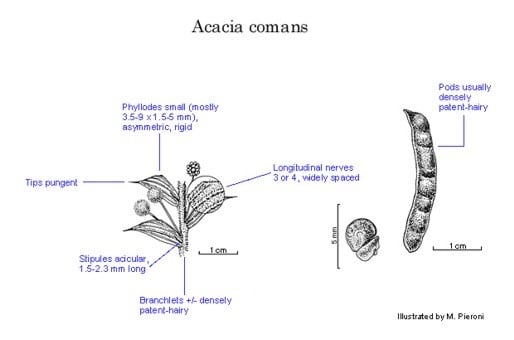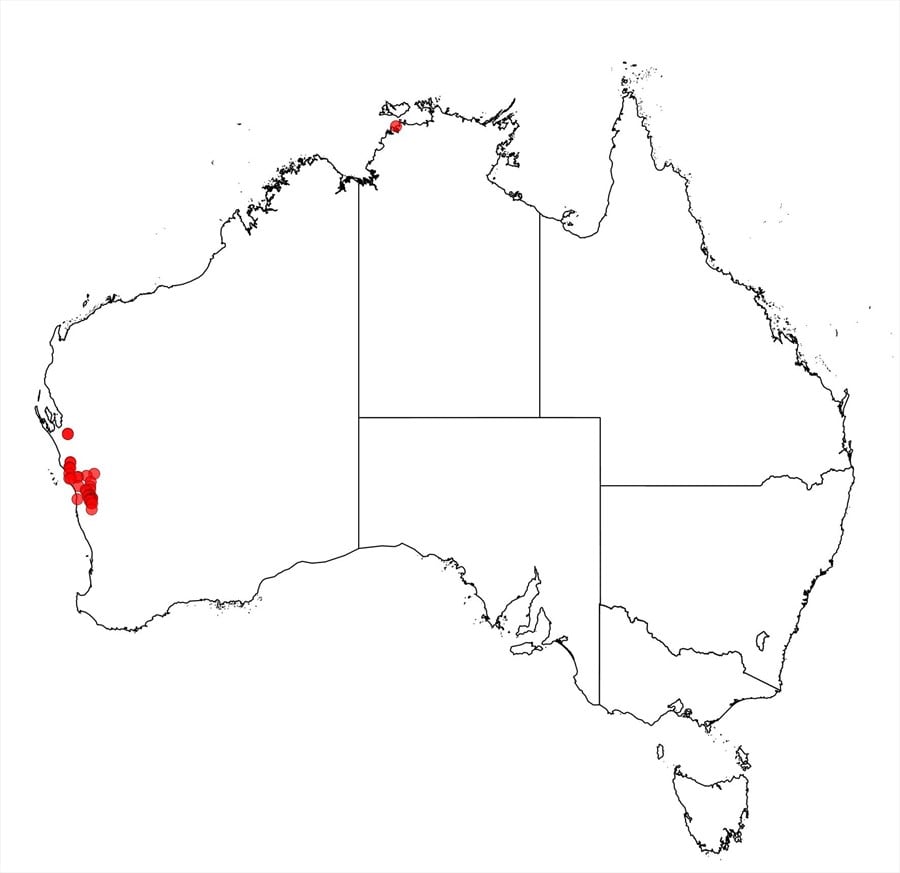Acacia comans W.Fitzg.
WATTLE
Acacias of Australia
Family
Fabaceae
Distribution
Occurs from the Geraldton area to SW of Coorow, W.A.
Description
Spreading shrub 0.3–2 m high. Branchlets terete, slightly ribbed, ±densely puberulous to pubescent with straight spreading hairs. Stipules persistent, acicular, 1.5–2.3 mm long. Phyllodes sessile, patent, widely elliptic to oblong, inequilateral, 3.5–9 mm long, 1.5–5 mm wide, pungent, rigid; main nerves 3 or 4, distant, raised, sparsely to densely hairy or glabrous; gland on upper margin, 1.5–3.5 (–6) mm from base. Inflorescences simple, 1 or 2 per axil; peduncles 5–15 mm long, normally glabrous; heads usually globular, 4–4.5 mm diam., 25–36-flowered, yellow. Flowers 5-merous; sepals free. Pods linear, raised over seeds, straight, to 4.5 cm long, 4–5 mm wide, coriaceous, with indumentum usually as on branchlets, normally with a faint light-coloured longitudinal midline on each valve. Seeds longitudinal, broadly oval to subcircular, turgid, ±3 mm long, mottled, brown; aril subapical to lateral, helmet-shaped.
Habitat
Grows in sandy soil.
Specimens
W.A.: Ebbano Well, E from Mingenew, 20 Sept. 1904, A.Morrison s.n. (NSW, PERTH); 11 km SW from Three Springs on road to Eneabba, B.R.Maslin 6415 (MEL, PERTH); 40 km from Brand Hwy towards Coorow, R.Cumming 1318 (PERTH).
Notes
Acacia comans is close to A. latipes, which differs in having caducous stipules and normally longer phyllodes, and to A. adnata, from which it is distinguished (perhaps somewhat arbitrarily) by its patent branchlet hairs and normally pilose pods (but see variants below). One specimen (B.R.Maslin 6586, PERTH) has obloid heads and another (F.W.Went 230, PERTH) has immature pods which are sparsely appressed-hairy.
The above description does not take into account the following two variants which, although seemingly referrable to A. comans as currently understood, need to be reassessed in the light of additional fruiting material and also a reassessment of A. latipes (which as currently defined is exceedingly polymorphic). The variants are distinguished by a number of features.
The first variant has branchlets with spreading hairs; phyllodes generally bigger (5–14 mm long), with the young phyllode nerves or margins shortly hairy, often glabrescent; pods sparsely appressed-hairy when young, glabrous at maturity. This variant is close to some forms of A. latipes, from which it differs in its ±persistent stipules. It occurs in the Moresby Ra., N of Geraldton and 16 km N of Northampton, W.A. (e.g. Howatharra Hill Reserve, Moresby Ra., D. & N.McFarland 1004, PERTH).
The second variant has branchlets with appressed indumentum; phyllodes relatively long and narrow, 5–15 mm × 1.5–2.5 mm, glabrous; pods unknown. It is very close to some forms of A. latipes, from which it differs in its persistent stipules. It occurs between 75 and 160 km N of Geraldton, W.A. (e.g. c. 16 km S of Murchison R. on North West Coastal Hwy, B.R.Maslin 2790, BRI, NY, PERTH).
FOA Reference
Data derived from Flora of Australia Volumes 11A (2001), 11B (2001) and 12 (1998), products of ABRS, ©Commonwealth of Australia
Author
Minor edits by J.Reid
R.S.Cowan, M.A.Lewington
This identification key and fact sheets are available as a mobile application:
URL: https://apps.lucidcentral.org/wattle/
© Copyright 2018. All rights reserved.







